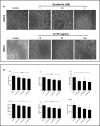The effect of interleukin-17F on vasculogenic mimicry in oral tongue squamous cell carcinoma
- PMID: 33743555
- PMCID: PMC8177764
- DOI: 10.1111/cas.14894
The effect of interleukin-17F on vasculogenic mimicry in oral tongue squamous cell carcinoma
Abstract
Oral tongue squamous cell carcinoma (OTSCC) is one of the most common cancers worldwide and is characterized by early metastasis and poor prognosis. Recently, we reported that extracellular interleukin-17F (IL-17F) correlates with better disease-specific survival in OTSCC patients and has promising anticancer effects in vitro. Vasculogenic mimicry (VM) is the formation of an alternative vasculogenic system by aggressive tumor cells, which is implicated in treatment failure and poor survival of cancer patients. We sought to confirm the formation of VM in OTSCC and to investigate the effect of IL-17F on VM formation. Here, we showed that highly invasive OTSCC cells (HSC-3 and SAS) form tube-like VM on Matrigel similar to those formed by human umbilical vein endothelial cells. Interestingly, the less invasive cells (SCC-25) did not form any VM structures. Droplet-digital PCR, FACS, and immunofluorescence staining revealed the presence of CD31 mRNA and protein in OTSCC cells. Additionally, in a mouse orthotopic model, HSC-3 cells expressed VE-cadherin (CD144) but lacked Von Willebrand Factor. We identified different patterns of VM structures in patient samples and in an orthotopic OTSCC mouse model. Similar to the effect produced by the antiangiogenic drug sorafenib, IL-17F inhibited the formation of VM structures in vitro by HSC-3 and reduced almost all VM-related parameters. In conclusion, our findings indicate the presence of VM in OTSCC and the antitumorigenic effect of IL-17F through its effect on the VM. Therefore, targeting IL-17F or its regulatory pathways may lead to promising therapeutic strategies in patients with OTSCC.
Keywords: Angiogenesis; CD31; Interleukin-17F; Oral tongue squamous cell carcinoma; Vasculogenic mimicry.
© 2021 The Authors. Cancer Science published by John Wiley & Sons Australia, Ltd on behalf of Japanese Cancer Association.
Conflict of interest statement
The authors have no conflict of interest.
Figures






Similar articles
-
Interleukin-17F Has Anti-Tumor Effects in Oral Tongue Cancer.Cancers (Basel). 2019 May 11;11(5):650. doi: 10.3390/cancers11050650. Cancers (Basel). 2019. PMID: 31083515 Free PMC article.
-
MTDH in macrophages promotes the vasculogenic mimicry via VEGFA-165/Flt-1 signaling pathway in head and neck squamous cell carcinoma.Int Immunopharmacol. 2021 Jul;96:107776. doi: 10.1016/j.intimp.2021.107776. Epub 2021 May 24. Int Immunopharmacol. 2021. PMID: 34162144
-
Downregulation of transgelin blocks interleukin-8 utilization and suppresses vasculogenic mimicry in breast cancer cells.Exp Biol Med (Maywood). 2017 Mar;242(6):573-583. doi: 10.1177/1535370216685435. Epub 2017 Jan 6. Exp Biol Med (Maywood). 2017. PMID: 28058861 Free PMC article.
-
Regulatory mechanisms and therapeutic targeting of vasculogenic mimicry in hepatocellular carcinoma.Pharmacol Res. 2021 Apr;166:105507. doi: 10.1016/j.phrs.2021.105507. Epub 2021 Feb 18. Pharmacol Res. 2021. PMID: 33610718 Review.
-
VE-Cadherin in Cancer-Associated Angiogenesis: A Deceptive Strategy of Blood Vessel Formation.Int J Mol Sci. 2023 May 26;24(11):9343. doi: 10.3390/ijms24119343. Int J Mol Sci. 2023. PMID: 37298296 Free PMC article. Review.
Cited by
-
The Role of IL-17 in the Pathogenesis of Oral Squamous Cell Carcinoma.Int J Mol Sci. 2023 Jun 8;24(12):9874. doi: 10.3390/ijms24129874. Int J Mol Sci. 2023. PMID: 37373022 Free PMC article. Review.
-
Variable roles of interleukin-17F in different cancers.BMC Cancer. 2022 Jan 11;22(1):54. doi: 10.1186/s12885-021-08969-0. BMC Cancer. 2022. PMID: 35012470 Free PMC article.
-
Interleukin-17F suppressed colon cancer by enhancing caspase 4 mediated pyroptosis of endothelial cells.Sci Rep. 2024 Aug 7;14(1):18363. doi: 10.1038/s41598-024-69436-x. Sci Rep. 2024. PMID: 39112724 Free PMC article.
-
Mast cells: key players in digestive system tumors and their interactions with immune cells.Cell Death Discov. 2025 Jan 15;11(1):8. doi: 10.1038/s41420-024-02258-y. Cell Death Discov. 2025. PMID: 39814702 Free PMC article. Review.
-
Lupeol and Paclitaxel cooperate in hindering hypoxia induced vasculogenic mimicry via suppression of HIF-1α-EphA2-Laminin-5γ2 network in human oral cancer.J Cell Commun Signal. 2023 Sep;17(3):591-608. doi: 10.1007/s12079-022-00693-z. Epub 2022 Sep 5. J Cell Commun Signal. 2023. PMID: 36063341 Free PMC article.
References
-
- Ng JH, Iyer NG, Tan MH, Edgren G. Changing epidemiology of oral squamous cell carcinoma of the tongue: a global study. Head Neck. 2016;39:297‐304. - PubMed
-
- Van Dijk BA, Brands MT, Geurts SM, Merkx MA, Roodenburg JL. Trends in oral cavity cancer incidence, mortality, survival and treatment in the Netherlands. Int J Cancer. 2016;139:574‐583. - PubMed
MeSH terms
Substances
Grants and funding
LinkOut - more resources
Full Text Sources
Other Literature Sources
Research Materials
Miscellaneous

